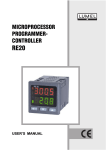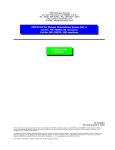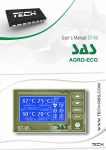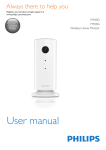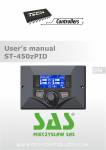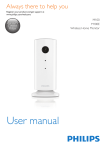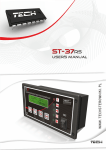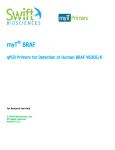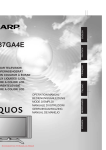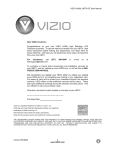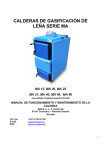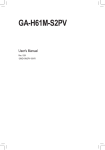Download ST-85
Transcript
ST-85 – USER'S MANUAL TECH Declaration of Conformity No. 35/2010 Hereby, we declare under sole responsibility that the ST-85 230V 50Hz thermoregulator manufactured by TECH, ul. St. Batorego 14, 34-120 Andrychów, is compliant with the Regulation by the Ministry of Economy. (Journal of Laws Dz.U. 155 Item 1089) of July 21, 2007 implementing provisions of the Low Voltage Directive (LVD) 2006/95/EC of January 16, 2007. The ST-85 controller has electromagnetic compatibility (EMC) been tested for with optimal loads applied. For compliance assessment, harmonized standards were used: PN-EN 60730-2-9:2006. Co-owners: Paweł Jura, Janusz Master -2- ST- 85 – USER'S MANUAL ATTENTION! HIGH VOLTAGE! Make sure the regulator is disconnected from the mains before working on the power supply (cable connections, device installation, etc.)! All connection works must only be carried out by qualified electricians. Before activating the controller, measure the motor resetting efficiency, check the boiler and inspect wire insulation. -3- Blow ST- 85 – USER'S MANUAL I. Description Manual Mode Blow H.C.W. Pump C.H. Pump Exit Standby Encoder knob The ST–85 temperature regulator is intended for use with central heating boilers. The regulator is used for controlling the central heating water circulation pump, hot consumption water pump and blow (fan). The ST-85 is a PID-basedcontroller using a continuous signal. In this type of controllers, the fan power is calculated based on boiler temperature and flue gas temperature measured at the boiler outlet. The fan runs continuously and its power depends directly on the measured boiler temperature and flue gas temperature as well as the difference between the two parameters and their setpoint values. Advantages of zPID regulators include their ability to maintain a stable setpoint temperature without unnecessary overregulations and oscillations. By fitting the controller with a flue gas outlet sensor, you can save from a few up to several percent of fuel, and ensure a steady water temperature for a longer service life of your heat exchanger (boiler). Flue gas outlet temperature monitoring ensures reduced harmful dust and gas -5- ST-85 – USER'S MANUAL emissions. The thermal energy from the flue gases is used for heating instead of being wasted and disposed of through the funnel. Research results presented below were obtained using the Tech PID-based controller: and the controller without PID control: You can change all parameters with an encoder knob. Turning the knob allows you to select a function or modify its value, while pressing the knob allows you to enter the function or confirm changed values. To leave any function, push the EXIT button. -6- ST- 85 – USER'S MANUAL I.a) Basic Terms Fire up. The cycle begins when you activate the fire up function in the controller's menu and is active until the central heating boiler temperature reaches 40oC (the default fire-up threshold), on condition that the temperature does not drop below this value for 2 minutes (the default fire-up time). If these conditions are met, the regulator will switch to the duty mode and the manual operation symbol on the housing will be deactivated. If the controller fails to reach parameters required for entering into the duty mode within 30 minutes from activation of the fire-up function, the "Unable to fire up" message will appear on the display. In such a case, the fire-up cycle needs to be restarted. Duty – once the fire-up cycle is finished, the controller enters the duty cycle. The duty cycle is the basic functionality of the regulator. The blow is controlled automatically using the zPID algorithm and the temperature is close to its setpoint value. In the user menu, fan item will appear in place of the fire-up function. The fan can be deactivated when needed (e.g. while feeding fuel). If the temperature rises unexpectedly by more than 5 oC over the setpoint value, the so-called Supervision Mode is activated. Supervision Mode – the mode is activated during the Duty Cycle if the temperature rises by more than 5oC over the setpoint value. In such case, the controller is switched from the PID control to manual settings (according to parameters entered in the Fitter’s Menu) to reduce the temperature of the circulation water. Damping – if boiler temperature drops by 2oC below the fire-up threshold and fails to rise above this value for 30 minutes (default damping time), the regulator will switch to thedamping mode. While in this mode, the fan is deactivated and the display shows "Damping". -7- ST-85 – USER'S MANUAL In case of voltage loss, the regulator ceases to operate. When power is restored, the controller returns to operation with previously set parameters using its built-in memory. Lack of voltage does not cause the stored parameters to be lost. II. Regulator Functionality This chapter describes regulator functionality, how to change settings and navigate in the menu with the encoder (knob). Depending on the mode the boiler is currently in, the display will show boiler operational parameters. The given mode is selected by the user. II.a) Main Page 42 Oc C.H. | 55 Oc * Setpoint During normal operation, the LCD display shows the Main Page containing the following: ● Boiler temperature (to the left of the display). ● Setpoint temperature (to the right of the display). ● Fan stop. After manually stopping the fan while in the duty mode, the star symbol ( ) will appear in the down right corner. ● Operation Mode. In the up right corner, the corresponding letter of the operation mode is displayed. Depending on the operation mode, the corresponding symbol is displayed: – house heating, – water heater priority, – parallel pumps, – summer mode. Pressing the encoder will move you to the main menu. The display shows two options of the menu. To select a different option, turn the encoder knob. -8- ST- 85 – USER'S MANUAL II.b) Changing the central heating and hot consumption water setpoint temperature. In order to change the setpoint temperature of the central heating (while in "C.H. screen" main view), turn the encoder knob and (after setting a desired value) press it to confirm the change. In order to change the setpoint temperature of the hot consumption water (while in "H.C.W. screen" main view), turn the encoder knob and (after setting a desired value) press it to confirm the change. Chapter "Screen" describes methods of changing the main screen view. II.c) Firing up This function allows you to easily fire up the boiler. After igniting the boiler, you need to activate an automatic fire-up cycle. By selecting optimum parameters, the boiler uses the zPID function to smoothly switch to the duty mode. If the boiler reaches the fire-up threshold temperature, the fan item will appear instead of the fire-up function. From now on, the option will be used to activate/deactivate the fan. This setting allows you to temporarily deactivate the fan at any time, e.g. while feeding fuel. If during the fire-up cycle the boiler does not reach 40 OC within 30 minutes, (default parameters), the following warning message will appear on the display: 38 Oc | 55 Oc unable to fire up To restore the boiler to operation, switch off the alarm by pressing the encoder and restarting the fire-up procedure. -9- ST-85 – USER'S MANUAL II.d) Manual Mode 42 Oc C.H. | 55 Oc Setpoint * For your convenience, the regulator features a manual mode module. In this mode, each individual actuator is enabled and disabled independently of the other. In addition to the Manual Mode function, the Blow Force function has been provided. Blow Force Fan 20% Blow Force This function allows you to set the blow force of the fan while in the Manual Mode. Pressing the ENCODER activates the fan. The fan will operate until the ENCODER is pressed again. Blow Force Fan Press the ENCODER to enable / disable the central heating pump. Fan C.H. Pump Press the ENCODER to enable / disable the (water heater) hot consumption water pump. C.H. Pump H.C.W. Pump Press the ENCODER to enable / disable the alarm. H.C.W. Pump Alarm - 10 - ST- 85 – USER'S MANUAL II.e) Fuel Type 42 Oc C.H. | Manual Mode Fuel Type 55 Oc Setpoint Coal Fines This option allows you to select one of three fuel types (coal, fines and wood) for use in the boiler. Each fuel type has a fan operation mode assigned to ensure the right burning process. II.f) Central Heating Pump Activation 42 Oc C.H. | Fuel Type C.H. Pump Activation 55 Oc Setpoint 35oc C.H. Pump Activation With this function, you can set the temperature that will activate the central heating pump (the temperature is measured on the boiler). The pump will start if the setpoint temperature is exceeded. The pump will be deactivated when the boiler temperature drops below the activation temperature (minus hysteresis, e.g. 2OC). In this case, the pump will stop at boiler temperature of 33OC. II.g) H.C.W. Pump Activation 42 Oc C.H. | 55 Oc Setpoint C.H. Pump Activation H.C.W. Pump Activation 40oc H.C.W. Pump Activation With this function, you can set the temperature that will activate the hot consumption water pump (the temperature is measured on the boiler). Above the setpoint temperature (e.g. 40 OC), the pump is activated and operates depending on the selected operation mode. The pump will be deactivated when the boiler temperature drops below the activation temperature (minus hysteresis, e.g. 3OC). In this case, the pump will stop at boiler temperature of 37OC. - 11 - ST-85 – USER'S MANUAL II.h) Operation Mode 42 Oc C.H. | H.C.W. Pump Activation Operation Mode 55 Oc Setpoint With this function, you can select one out of four operation modes. II.h.1) House Heating House Heating * H.C.W. Priority If you select this option, the regulator will switch to the house heating mode. The central heating pump starts to run above the pump activation temperature (set to 35OC by default). Below this temperature (minus central heating hysteresis), the pump is shut off. While in the house heating mode, the icon is displayed in the up right corner of the main screen. II.h.2) H.C.W. Priority House Heating H.C.W. Priority * Activating the hot consumption water priority will cause the regulator to switch into consumption the water heater priority mode. In this mode, the (hot water) heater pump is activated until the set H.C.W. temperature is reached. Then, the H.C.W. pump is shut off and the C.H. pump is activated. The central heating pump will run until the water heater temperature drops below the setpoint value (and the H.C.W. hysteresis); then, the C.H. pump is shut off and the H.C.W. pump is activated. In this mode, the fan is operated as long as the temperature is below 62°C to prevent the boiler from overheating. The hot consumption water priority function consists in that consumption water is heated up before heating up water in radiators. - 12 - the ST- 85 – USER'S MANUAL While in the H.C.W. Priority mode, the icon is displayed in the up right corner of the main screen. ATTENTION: The boiler should have non-return valves mounted on the central heating pump circuit and the hot consumption water pump circuit. A valve mounted on the hot consumption water pump will prevent hot consumption water from being drawn from the water heater. II.h.3) Parallel Pumps H.C.W. Priority Parallel Pumps * 42 Oc C.H. | 55 Oc Setpoint In this mode, the pumps start to run in parallel above the pump activation temperature (set by default to 35OC). These temperatures may, however, vary depending on user settings. This will cause irregular activation of the pumps. However, when both thresholds are exceeded, the pumps will operate simultaneously. The central heating pump runs continuously, while the hot consumption water pump stops after the setpoint temperature is reached in the water heater. While in the Parallel Pumps mode, the icon is displayed in the up right corner of the main screen. ATTENTION: In this mode, a non-return valve should be fitted to maintain different temperatures in the water heater and in the house. After activation of the parallel pumps function, three items appear on the display. Starting from the left, these are: Boiler Temperature (C.H.); Water Heater Temperature (H.C.W.) and Setpoint Temperature (C.H.). II.h.4) Summer Mode Parallel Pumps Summer Mode * 45 Oc 43 Oc 55 Oc C.H. H.C.W. Set When the function is enabled, only the hot consumption water pump is - 13 - ST-85 – USER'S MANUAL running in order to heat water in the water heater. The pump is switched on above a predefined activation threshold (see the pump activation temperature function) and will run until the setpoint temperature has been reached. The pump will start again when the temperature drops below the set hysteresis. In the Summer Mode, only the setpoint temperature is set on the boiler that heats up water for the water heater (the temperature set for the boiler is also the temperature set for the water heater). While in the Summer Mode, the icon is displayed in the up right corner of the main screen. II.i) Main Screen OPERATION MODE MAIN SCREEN This function allows you to change the view of the main screen. The following views are available: ➢ C.H. SCREEN • C.H. SCREEN H.C.W. SCREEN 44 Oc C.H. | 55 Oc Setpoint This screen displays the current and setpoint C.H. temperatures. By turning the knob, you can change the setpoint temperature. After setting the appropriate value, confirm it by pressing the encoder knob. ➢ H.C.W. SCREEN C.H. SCREEN • H.C.W. SCREEN 43 Oc H.C.W. | 50 Oc Setpoint This screen displays the current and setpoint H.C.W. temperatures. By turning the knob, you can change the setpoint H.C.W. temperature. After - 14 - ST- 85 – USER'S MANUAL setting the appropriate value, confirm it by pressing the encoder knob. ➢ FLUE GASES SCREEN H.C.W. SCREEN • FLUE GASES SCREEN 45 Oc 93 Oc 80% C.H. FLUE FAN The following items are displayed, starting from the left: current C.H. temperature, current flue gases temperature and blow power in percentages. This view is used for monitoring current boiler parameters. II.j) Language MAIN SCREEN LANGUAGE With this function, you can select the language of your controller. II.k) Factory Settings 23 Oc | 55 Oc Setpoint Fixed C.H. Pump Factory Settings Yes No The regulator has been pre-configured. However, it should be adjusted to your individual needs. It is possible to return to the factory settings at any time. By enabling the Factory Settings, all existing boiler settings will be replaced by settings made by the manufacturer. From then on, you can again set your own operating parameters for the boiler. II.l) Fitting parameters Access to fitting parameters is disabled for the user. This special view contains advanced parameters accessible only by the manufacturer. - 15 - ST-85 – USER'S MANUAL III. Protections In order to ensure a safe and faultless operation, the regulator has been provided with numerous protections. In the case of an alarm, an acoustic warning is sounded and the display shows a corresponding message. Press the encoder to restore the controller to operation. In the case of the C.H. Temperature Too High alarm, wait until the temperature drops below the alarm value. III.a) Thermal protection The boiler is protected with an additional bimetal sensor (located at the boiler temperature sensor) that disables the fan when the temperature exceeds the critical value: 85 OC. This is to prevent water from boiling in the system when the boiler has been overheated or the controller is damaged. When the protective function is enabled and the temperature drops to a safe value, the sensor will automatically restart the device and the alarm will be deactivated. If the sensor is damaged or overheated, the burner, fan and feeder are disabled. III.b) Automatic Sensor Check When the temperature sensor of the central heating or hot consumption water is damaged, an alarm is sounded with an additional indication shown in the display, e.g.: „C.H. Sensor Damaged". Alarm C.H. Sensor Damaged Blow is disabled and both pumps are activated simultaneously, regardless of the temperature. If the central heating sensor is damaged, the alarm will remain active until the sensor is replaced. If the hot consumption water sensor is damaged, pressMENU to deactivate the alarm and restore the single (house heating) - 16 - ST- 85 – USER'S MANUAL pump mode. To be able to operate the boiler in all modes, it is necessary to replace the sensor. III.c) Temperature Protection The regulator features an additional protection in case the bimetal sensor is damaged. After the temperature exceeds 85 OC, the alarm is sounded with the display showing the following message: Alarm Temperature Too High The current temperature is read from an electronic sensor and processed by the thermoregulator. When the alarm temperature is exceeded, the fan is shut off and both pumps begin to run in order to distribute hot consumption water throughout the system. III.d) Anti-Boil Protection This protective function is used only with the water heater priority mode. For example, when the water heater setpoint temperature is 55 OC and the boiler temperature rises to 67OC (5OC over the so-called priority temperature), the controller shuts off the fan.If the boiler temperature reaches 80OC, the C.H. pump will be activated. If the temperature continues to rise, the alarm will be activated at 85 OC. Such condition may appear when the water heater or the pump is damaged or when the sensor has been improperly installed. However, if the temperature drops, the controller will activate the fan at 66OC and it will remain in the duty mode maintaining the priority temperature of 62OC. - 17 - ST-85 – USER'S MANUAL III.e) Monitoring the flue gas outlet temperature 23 Oc C.H. 98 Oc Flue 50% Fan D This sensor constantly monitors the flue gas outlet temperature. If the sensor is damaged, disconnected from the controller or removed from the flue conduit, Flue Gas Sensor Damaged massage will appear on the display. This will cause the controller to switch to the emergency mode. In such case, only boiler temperature is used. The controller is operated using only the boiler sensor and the zPID function remains active without the flue gas outlet sensor. III.f) Fuse The regulator has a network protection WT 3.15 A tube fuse. Higher current ratings may cause damage to the controller. IV. Maintenance Before and during the heating season, the ST-85 controller should be checked for condition of its cables. You should also check if the controller is properly mounted and clean it if dusty or dirty. It is advisable to measure grounding parameters for the consumption water pump and fan) - 18 - motors (central heating pump, hot ST- 85 – USER'S MANUAL ST-85 Technical Specifications No. Specification Unit 1 Supply Voltage V 230V/50Hz +/-10% 2 Power consumption W 5 3 Ambient temperature O 4 Circulation pump outlet load A 0,5 5 Fan outlet load A 0,6 6 Temperature measurement range O C 0÷90 7 Measurement accuracy O C 1 8 Sensor thermal resistance O C -25÷90 9 Fuse insert A C 5÷50 3,15 V. Assembly ATTENTION: all assembly works must only be carried out by qualified persons. During assembly, the device must be disconnected (make sure the power cord is unplugged)! ATTENTION: improper cable connections may damage the regulator! The regulator may not be operated in a closed-circuit central heating system. It is necessary to provide for safety valves, pressure valves and a surge tank in order to prevent water from boiling in the central heating system. V.a) Cable Connection Diagram for Controller Pay special attention to cable connections during assembly. Especially, the ground wire should be connected properly. - 19 - ST-85 – USER'S MANUAL - 20 - ST- 85 – USER'S MANUAL We are committed to protecting the environment. Manufacturing electronic devices imposes an obligation of providing for environmentally safe disposal of used electronic components and devices. Hence, we have been entered into a register kept by the Inspection For Environmental Protection. The crossed-out bin symbol on a product means that the product may not be disposed of to household waste containers. Recycling of wastes helps to protect the environment. The user is obliged to transfer their used equipment to a collection point where all electric and electronic components will be recycled. - 21 - ST-85 – USER'S MANUAL Table of Contents I. Description....................................................................................... 5 II. Regulator Functionality...................................................................... 8 II.a) Main Page.................................................................................. 8 II.b) Changing the central heating and hot consumption water setpoint temperature...................................................................................... 9 II.c) Firing up.................................................................................... 9 II.d) Manual Mode............................................................................ 10 II.e) Fuel Type................................................................................. 11 II.f) Central Heating Pump Activation..................................................11 II.g) H.C.W. Pump Activation............................................................11 II.h) Operation Mode......................................................................... 12 II.h.1) House Heating.....................................................................12 II.h.2) H.C.W. Priority.................................................................... 12 II.h.3) Parallel Pumps.....................................................................13 II.h.4) Summer Mode.....................................................................13 II.i) Main Screen............................................................................... 14 II.j) Language.................................................................................. 15 II.k) Factory Settings........................................................................ 15 II.l) Fitting parameters...................................................................... 15 III. Protections.................................................................................... 16 III.a) Thermal protection...................................................................16 III.b) Automatic Sensor Check............................................................16 III.c) Temperature Protection.............................................................17 III.d) Anti-Boil Protection...................................................................17 III.e) Monitoring the flue gas outlet temperature..................................18 III.f) Fuse........................................................................................ 18 IV. Maintenance.................................................................................. 18 V. Assembly........................................................................................ 19 V.a) Cable Connection Diagram for Controller.......................................20 - 22 - ST- 85 – USER'S MANUAL - 23 - ST- 85 – USER'S MANUAL - 24 -
























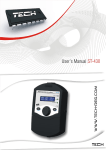
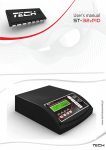

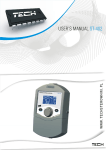
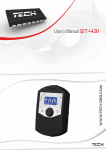
![Manuel d`utilisation Régulation TECH ST3[...]](http://vs1.manualzilla.com/store/data/006377962_1-761c4fa99f631e7c2b8551b5818edead-150x150.png)
